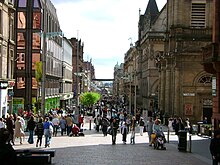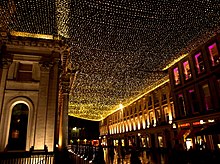Glasgow city centre
Glasgow City Centre is the central business district of Glasgow, Scotland. Is bounded by Saltmarket, High Street and Castle Street to the east, The River Clyde to the south and the M8 motorway to its west and north. Glasgow City Centre is composed of the areas of Garnethill, Blythswood Hill and Merchant City as well as parts of Cowcaddens, Townhead, Anderston and Calton.
Retail and Theatre District

The city centre is based on a
The city centre is home to most of Glasgow's main cultural venues:
Merchant City

To the east is the commercial and residential district of
From the late 1980s onwards, the Merchant City has been rejuvenated with luxury city centre apartments and warehouse conversions. This regeneration has supported an increasing number of cafés and restaurants.[6] The area is also home to a number of high end boutique style shops and some of Glasgow's most upmarket stores.[7]

The Merchant City is the centre of Glasgow's growing 'cultural quarter', based on King Street, the Saltmarket and Trongate, and at the heart of the annual Merchant City Festival. The area has supported a huge growth in art galleries, the origins of which can be found in the late 80s when it attracted artist-led organisations that could afford the cheap rents required to operate in vacant manufacturing or retail spaces.[8] The artistic and cultural potential of the Merchant City as a 'cultural quarter' was harnessed by independent arts organisations and Glasgow City Council,[8] and the recent development of Trongate 103, which houses galleries, workshops, artist studios and production spaces, is considered a major outcome of the continued partnership between both.[9] The area also contains a number of theatres and concert venues, including the Tron Theatre, the Old Fruitmarket, the Trades Hall, St Andrew's in the Square, Merchant Square, and the City Halls.[10]
A large part of Glasgow's LGBT scene is located within the Merchant City. This includes many clubs, along with a couple of saunas. Recently the city council defined (and perhaps expanded) the area known as Merchant City as far west as Buchanan Street, marking these boundaries with new, highly stylised metal signage.[11]
Financial district

To the western edge of the city centre, occupying the areas of
References
- ^ The Academy of Urbanism : Awards https://web.archive.org/web/20080119212642/http://www.academyofurbanism.org.uk/awards.htm Retrieved 28-05-2008
- ^ "Retail Ranking from Experian" (PDF). Business-strategies.co.uk. Archived from the original (PDF) on 26 March 2009. Retrieved 12 September 2009.
- ^ "Top of the Shops - Gerald Eve Publishes Prime Retail". Prnewswire.co.uk. 5 November 2004. Retrieved 12 September 2009.
- ^ "A Quick Guide To Glasgow". GlasgowCityCentre.co.uk. Retrieved 19 June 2012.
- ^ "Glasgow's Merchant City: Historical Development". Merchant City Initiative. 2008. Archived from the original on 13 May 2008. Retrieved 29 July 2008.
- ^ "Merchant City Glasgow: Restaurants and Cafés". Merchant City Glasgow - Merchant City Initiative. 2008. Archived from the original on 16 June 2008. Retrieved 30 July 2008.
- ^ "Merchant City Glasgow: Shops". Merchant City Glasgow - Merchant City Initiative. 2008. Archived from the original on 16 June 2008. Retrieved 30 July 2008.
- ^ a b "Merchant City Glasgow: Galleries and Art". Merchant City Glasgow - Merchant City Initiative. 2008. Archived from the original on 16 June 2008. Retrieved 30 July 2008.
- ^ "Trongate 103". 2008. Archived from the original on 1 November 2008. Retrieved 30 July 2008.
- ^ "Merchant City Glasgow: Venues and Theatres". Merchant City Glasgow - Merchant City Initiative. 2008. Archived from the original on 16 June 2008. Retrieved 30 July 2008.
- ^ Merchant City Glasgow http://www.merchantcityglasgow.com/
- ^ "Let Glasgow flourish". Scotland: the official online gateway. Retrieved 29 July 2008.
